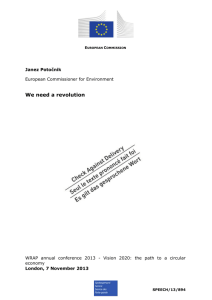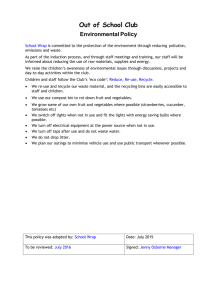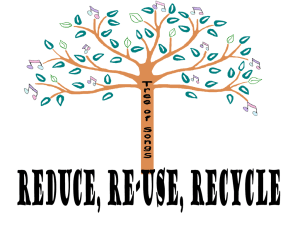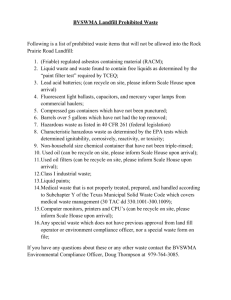Improving the resource efficiency of processes
advertisement
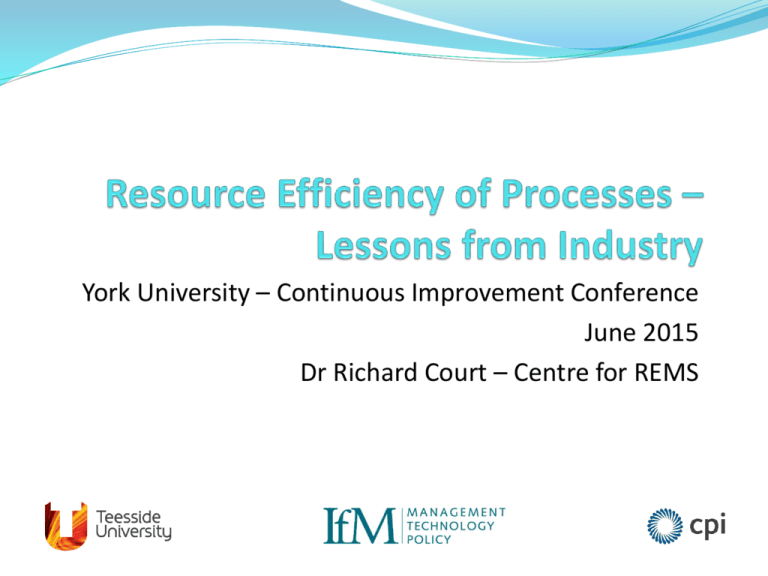
York University – Continuous Improvement Conference June 2015 Dr Richard Court – Centre for REMS Workshop Outline Presentation and scene setting (10 minutes) Demonstration of modelling technique – improvements to an industrial system (15 minutes) Examples of possible applications in a University setting (5 minutes) Discussion & interactive session (15 minutes) Presentation & Scene Setting Centre for Resource Efficient Manufacturing Systems (REMS) A collaboration between: CPI, IfM, Teesside University The REMS aim is: To encourage the optimization of resource use in a way that improves manufacturing efficiency, reduces environmental impact, increases economic value and creates social benefit. To use modelling and systems analysis of whole supply chains to create knowledge and understanding of the way resources flow within and are consumed in manufacturing processes. Title for today: Improving the resource efficiency of processes within universities – lessons from industry that use representations and models of the flow of items (e.g. materials, items, people) through processes and systems Problem Definition Linear economies, “take-make-use-dispose” and their growth, have massively contributed to developing today’s society. But, is it the most efficient use of resources? REMS research is directed at examining this resource use by the overall system, and how to secure resources for the future. Is “circularisation” of resource flow more efficient? Raw Materials Resources - Concepts discussed in: C. Campbell & R. Court, Steps towards a circular economy – what can we do?, eg Recycle magazine, 19 (5), 2014 - Used by APSRG Remanufacturing report. Landfill Manufacturing Remanufacture Use Reuse Possible types of dynamic “flow” modelling Image from www.anylogic.com Modelling the “flow”? The technique of Discrete Event Simulation (DES), focusses on a “process-centric” view of the situation. Useful for scientists and engineers to model processes without prohibitive levels of detail. A key point is that DES is a dynamic model – changes with time “Entities” travel through a process. Various “operations” dictate the fate of each entity. REMS uses DES for its balance between: Complexity – can be made more or less to suit situation & audience Reflecting reality – many aspects of life have this “flow” Comprehensibility – the results make sense – with hind sight A Discrete Event Simulation (DES) software package – one example is AnyLogic Why use computers and software? Because it is hard to perform it as a spreadsheet calculation, or to set up a series of closed-form equations – except for very trivial examples. Presentation of DES models developed by the Centre for REMS: An example from a real REMS case-study for industry – polymer moulding for the automotive industry: Complex, but gives a flavour of what can be undertaken. A simple worked example for this CIC workshop: Considers polymer production, manufacture and use of a “part” Compares the linear versus circular supply chains that can exist Automotive – nylon supply chain Static pictorial model developed by REMS Raw materials through to resin and user Developed a dynamic model of these stages “What if?” scenarios possible Automotive – nylon case study DES model – 4 stages - compounding, moulding, use, disposal Company interested in: non-oil sources of material; recycled material; “take back” parts schemes; etc. and company’s long-term strategy Simple DES example – linear supply chain Polymer production and use of a part Tonnes of material extracted, processed, produced, used over 5 years. Check the effect of: i) production efficiency – 50% or 90% ii) constraint on either production or use phase of life Linear supply chain - Results 5000 50% or 90% - scaled reduction in tonnes extracted and to landfill Constraint on use or production – large effect on amount of material needed… Implications for policy makers on unrestricted consumption…? Tonnes of Material Production efficiency – 4500 Oil processed 4000 Parts used 3500 Landfill 3000 2500 2000 1500 1000 500 0 Production 50% efficient - Production 90% efficient - Production 90% efficient use constraint use constraint production constraint Simple DES example – circular supply chain Polymer production and use, re-use and recycle of a part Tonnes of material over 5 years. Check the effect of: i) re-use vs recycle ratio on tonnes used and extracted ii) other variables constant, e.g. 90% production efficiency Re-use Recycle Circular supply chain - Results Four scenarios compared: Scenario Production Efficiency (%) Landfill (%) Re-use (%) Recycle (%) Linear 90 100 0 0 Circular 90 30 60 10 Circular 90 30 40 30 Circular 90 30 10 60 Circular supply chain - Results Re-use – Recycle. More recycling = fewer parts available for use… why? Because production becomes the limiting factor. Implications for policy makers on what to measure/control, GDP value and what is effective…? 12000 Oil processed 10000 Tonnes of Material Linear – Circular. More parts used; less oil processed…! Parts used Landfill 8000 6000 4000 2000 0 Linear Circular Re-use 60% Circular Re-use 40% Circular Re-use 10% Recycle 10% Recycle 30% Recycle 60% Applications in University Systems? Equipment for practical sessions. Materials for laboratories. Students progressing through modules / courses. Planning of events / conferences – visitor numbers and required facilities / resources. Others…? Discussion and Interaction Departments / Facilities / Areas that attendees work in? “Flows” of entities in day-to-day activities?. Mapping of flows and processes - sketch Discussion – good / bad aspects of DES technique? Thank you Centre for Resource Efficient Manufacturing Systems (REMS) Dr Richard Court – r.court@tees.ac.uk https://twitter.com/Centre4REMS/

